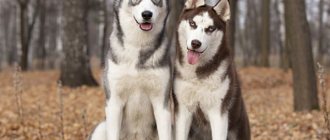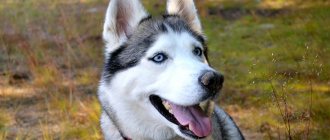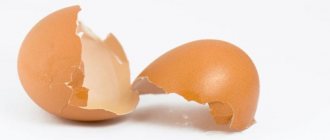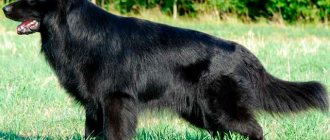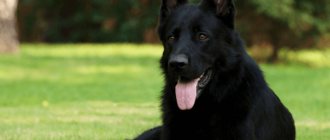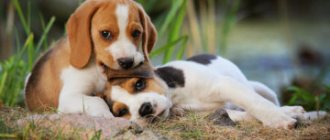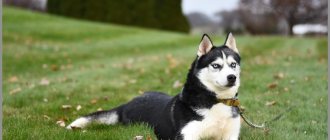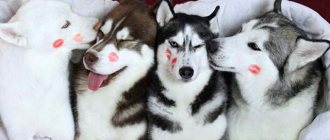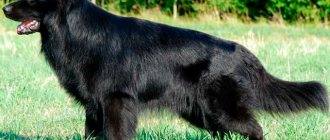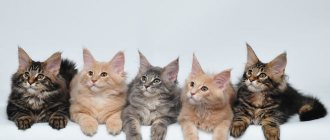Siberian Huskies are one of the most beautiful and intelligent dogs. Dogs are hardy, strong, loyal to their owners. They are distinguished by good health, friendly disposition, and unique appearance.
Researchers claim that representatives of the Siberian breed were bred by the aborigines of the north and belong to the oldest type of dog, endowed with genes similar to those of wolves. Fur hunters and researchers used the potential of dogs when going on sled trips. In the middle of the 19th century, huskies began to be exported to North America for further breeding.
Dog breeders consider the breed unique. The reason is his unusual appearance. Each dog has a special shade of fur and pattern. You won't be able to find two absolutely identical pets.
Huskies come in a variety of colors. Over 20 colors of the animal are known. 4 are officially registered.
This is interesting: Characteristics of the Siberian Husky
Acceptable coat color in combination with white:
- gray (most popular),
- brown,
- black.
A white dog with blue eyes is a rarity.
Maintenance and care
Husky dogs need daily care and attention. You don’t need any special skills or abilities, but you should take care of the animal every day. This will help keep the coat shiny and well-groomed. The coat should be combed with a metal comb or comb 2-3 times a week. Such devices help remove excess undercoat and remove all dirt and debris that may be brought from the street.
During the molting period, huskies are brushed 2 times a day, paying special attention to the chest and neck areas. First, remove the dead undercoat with a slicker brush, and then comb it out with a metal comb.
The white husky is no different from other representatives of this breed; it requires the same care and attention. But there are small nuances in washing
You don’t need to buy a husky often; once a quarter is enough. But be sure to use a special shampoo for white dogs.
To protect your pet’s snow-white fur coat in rainy weather, you can dress your pet in a special overall. Since dogs of this breed do not freeze, they only purchase protective clothing.
In winter, a bright collar is purchased for a snow-white dog, since the pet is easily lost against the background of snow. This dog should be walked on a free-running leash. Even with training, a husky can escape. The desire to escape is in the blood.
It is very important to train your dog from early childhood. They can always talk about habits and peculiarities of upbringing when attending group classes with a dog handler.
With representatives of this breed you can engage in any kind of sports, both in summer and winter.
Basic rules of care
Brown huskies need to be brushed twice a week, but when the dog is shedding and it is necessary to remove as much loose undercoat as possible, this will have to be done at least once a day.
It is not often necessary to bathe a pet of this breed: it is enough to wash it with a special shampoo 2-3 times a year, but it is better to do without bathing at all if this is not necessary.
The eyes and ears of a brown husky also need to be cleaned only if they are dirty, but they should be examined every day in order to notice the first signs of possible inflammation or other disease in time.
The teeth of these dogs, as a rule, do not need additional cleaning: it is enough to feed the pet fairly solid food and give it cartilage or special treats from time to time to help remove plaque.
CAREFULLY! Husky claws are trimmed if they grow so long that their tips bend inward.
In this case, it is recommended to use a nail clipper, and if the owner doubts that he can shorten the dog’s claws without injuring him, then he should contact a veterinary clinic.
Advantages and disadvantages
- Brown Huskies are smart and quick-witted.
- These are dogs that can correctly assess the situation and make decisions independently if necessary.
- They look beautiful and impressive, especially if they have brownish-copper colored fur and blue eyes.
- There is no aggression towards people.
- They treat children well: they willingly look after the kids and become excellent companions for them when they grow up.
- They adore their owners and are ready to follow them everywhere.
- They are easy to care for.
- Suitable for both home and apartment use.
- Hardy and quite unpretentious in maintenance and feeding.
- Brown huskies tend to be stubborn at times.
- They love to dig up the earth and are not averse to undermining.
- Predisposed to escape and wandering.
- Out of boredom, they can begin to damage furniture or other things in the house.
- They love to howl like wild predators.
- If not socialized, they can be dangerous to smaller pets.
- Not suitable as a hunting or guard dog.
- They are very mobile and need a lot of physical activity and long walks.
Description of colors with photographs
According to the breed standard, Siberian Huskies are allowed any color except white, if it is associated with albinism, that is, with a complete absence of pigment in the dog’s body.
However, it should be taken into account that with any single-color colors there must be at least small white markings.
NOTE! With most solid colors, the husky necessarily has lightening of the coat to white on the head, muzzle, neck, chest, belly, lower paws, and also, often, on the tail and the inside of the ears. In addition, this breed is characterized by white markings such as a white mask, glasses and a pattern on the forehead shaped like a shamrock.
In addition, this breed is characterized by white markings such as a white mask, glasses and a shamrock-shaped forehead pattern.
Below are descriptions of colors with names and photographs.
Agouti
The color, also called “agouti,” is most characteristic of the racing husky variety. With this color, the guard hair has a gradient color: it alternates areas of black, gray and reddish shades, while the undercoat is usually cream-colored.
Piebald
Piebald is a very beautiful color. With this color, there are spots on the husky’s fur coat, the area of which should not exceed 30% of the total.
This is the rarest color of the husky, characterized by a marbled spotted coat pattern.
Pale yellow
Fawn is reminiscent of a light red color, but softer and more noble, somewhat similar to beige or dark cream.
Chocolate
This coat color is more like a dark copper color rather than a chocolate color. Characterized by special depth, brightness and saturation.
Can be any shade of brown, from light to dark chocolate.
Ginger
This color requires the presence of at least small white markings on a jet-black background.
White
The shade of the purest snow-white shade is desirable; no colored spots or darkening on the coat is allowed in this color.
Sable
If the dog has a sable color, then the hairs have a lighter, fawn or red tint at the base and almost along their entire length, but their tips are darkened to black or, less often, dark brown.
Isabella
If a husky has an Isabella color, then such a dog looks very light, almost white, but the tips of its hairs are light fawn or reddish.
Rare husky colors
The most common color is gray. A white dog with blue eyes is not common, as are the rare husky colors presented in the table:
| Color | Description |
| White | Another name is snowy. Dogs have white not only guard hair, but also undercoat. Eyes are light brown, blue or different. |
| Soboliny (sable) | Sable Khasenysh with a bright copper undercoat. The spine is gradient - the color at the base is beige, and at the end it is dark gray, black-brown. The lips and eye rims are black. The nose may be brown. |
| Piebald | Piebald or spotted coloring involves a white background, occupying at least 70% of the husky's coat, and colored markings. They are of different shapes (round, asymmetrical) and colors (from red to black). Another name for the piebald color is pibold. |
| Black | There are no completely black huskies. Lighter markings are required on the legs, tail, and chest. If the pure charcoal color is at least 75%, the dog is classified as black or called an Afro Husky. |
| Black and white | In black and white, the percentage of the two colors is approximately the same. Dark back, main part of tail, outer side of ears. White muzzle with a mark on the forehead and paws. |
| Splash coat | Splash Coat Husky and Peebold are often confused. This is no coincidence. Both are black and white, with blue eyes, only the number and shape of the markings are different. Their arrangement in splash coats is often called “coat and cap”. The main difference is that there is more white than black and there is a light ring on the neck. |
| Tricolor | The background is black, and the muzzle, paws and chest are snow-white. A distinctive feature of the tricolor is the red markings near the eyes, on the body and limbs. The husky's undercoat can be yellow, peach or orange. |
| Marble | Rare huskies with a black muzzle, back, tail and hips, a random arrangement of spots on a light background. Markings of gray color of varying intensity. Eye rims, nose and lips are black. |
| Isabella | The dog has white fur with a fawn-colored awn. Eyes, nose, mucous membranes are brown. |
| Agouti | A rare color in which the hairs come in three shades at once - white, black and red. In combination with blue eyes, the husky looks menacing and unusual. |
| Cheprachny | A special feature of the saddle coat color is a dark saddle-shaped spot on the back. The mark, located on a snow-white background, can be of all types of colors - red, chocolate, gray and others. |
What color are husky eyes?
Eye color must correspond to breed standards. Iris colors characteristic of purebred huskies:
- blue;
- brown;
- multi-colored.
Different shades of the listed colors are possible. There are no huskies with green eyes, but an olive tint is possible. This color is found in brown-eyed dogs.
Other colors are not typical for the breed and indicate that the dog is not purebred.
Blue-eyed huskies
The most popular and most frequently encountered are blue-eyed huskies. Previously, this color of the iris was considered a defect. Breeders were sure that the blue color of the iris indicated blindness or poor vision. Blue-eyed dogs were not allowed to be bred. This is why dogs with blue eyes are rare among other northern breeds.
During breeding work with huskies, breeders, on the contrary, focused on breeding blue-eyed pets, which became the hallmark of the breed.
The iris has a heavenly color and is surrounded by a dark rim. The shade is light, making the animal’s gaze seem piercing and frightening.
This breed feature is associated with a genetic anomaly that does not affect the dog’s health in any way. It occurs due to an insufficient amount of pigment in the iris. Visual acuity does not suffer from this.
All Husky puppies are born with blue irises. You can be sure that a husky’s eyes will remain like this for the rest of his life only when the animal is six months old.
This is why a breeder's assurances regarding a puppy's blue eyes should be treated with caution. Colors characteristic of blue-eyed dogs:
Colors characteristic of blue-eyed dogs:
- black;
- chocolate;
- black and white;
- grey;
- ginger.
White huskies with blue irises are rare. They often have black noses and lips and dark eyes. Albinos are even rarer. They are all white huskies with blue eyes, light lips and nose. The iris is almost white or red.
Brown-eyed huskies
Dogs with brown eyes are not much less common than their blue-eyed counterparts. The color of the iris can vary from honey to black. In brown-eyed huskies, the iris is saturated with a sufficient amount of pigment, so its color is bright and dense.
Amber eye color looks impressive. In certain lighting it appears golden or bright orange, and sometimes has a green tint.
Husky colors - variety of colors of the breed, table of rare colors
Siberian Huskies have long ceased to be just sled dogs. They are distinguished by their calm and calm character, endurance, and kind attitude towards others, which is why dog breeders all over the world adopt charming puppies with blue eyes. Few people know which husky colors correspond to the standard, and which color is classified as a breed defect. Before you buy a cute little cat, it’s worth getting to know the most common color options for its coat.
Are there other varieties?
There is only one variety of this breed - the Siberian Husky. These are the dogs that can be seen on the street, at exhibitions, in films and in photographs popular on the Internet.
They are also used as sports and riding vehicles. Currently, there are few working huskies left, since dogs of show lines, which are in greatest demand among buyers, are mainly bred.
Siberian Huskies have also gained popularity as pets and companions. This was facilitated by their friendly disposition, lack of aggression towards humans and love for children. Also, a significant role in the popularization of the breed was played by the fact that huskies are one of the few breeds whose representatives have blue eyes and even heterochromia.
Touched by the appearance of these dogs, people sometimes lose sight of the fact that huskies are not suitable for guarding and that they make poor hunting assistants.
Now let's talk about dogs that, while not being subspecies of this breed, nevertheless have similarities and often common origins with the Siberian Husky.
Description of the breed
medium-sized sled dog , distinguished by endurance, good speed qualities and the ability to navigate the terrain well.
Bred by tribes inhabiting the northern part of the Far Eastern region of Russia in ancient times, the breed developed and improved under harsh weather conditions and almost natural selection, since human intervention in the selection of pairs was insignificant.
Being left to their own devices in the warm season, sled dogs were forced to get their own food , thanks to which they developed a hunting instinct, which modern representatives of this breed have inherited.
Since in those tribes it was not customary to divide property and territory into theirs and someone else’s, people did not need sled dogs to have guarding or protective qualities.
NOTE!
The modern husky has a friendly and affable character, he is active and playful, although sometimes he is prone to mischief.
These dogs' inherent loyalty to their owners, love of children and ability to adapt make them suitable as family pets.
However, you need to take into account that training a husky may not be such a simple matter, since these dogs are very freedom-loving and independent, and if something does not suit them, they can become stubborn and stop obeying their owner.
Husky dog eyes
The Husky's eye color, as prescribed by breed standards, requires some variety and can have the following shades:
- Brown.
- Amber.
- Blue.
- Olive.
- Heterochromic (that is, they are different-eyed Huskies, also called “harlequins”).
Individuals with blue eyes
The most common variant of the breed's exterior is the Husky with blue eyes surrounded by a clear dark, almost black rim. Such eyes can be found in black and white, gray and white, and gray individuals.
But white Huskies with blue eyes are quite rare individuals, so true connoisseurs of the breed often dream of purchasing just such a dog. According to dog handlers, blue-eyed white Huskies are the friendliest to humans and love active games and live communication with their owner.
The color of a white dog’s nose can be either black (it harmonizes very nicely with the rim around the eyes!), or a paler brown shade, or even a light cream color.
This transparent, icy look can charm anyone, because dog breeds with blue eyes are very rare. The Siberian Husky is practically the only breed whose standards officially allow this iris color.
Dogs with black and brown eyes
Husky dogs with brown eyes, eyes of a darker, almost black color, are also quite common. At the same time, the color of a brown-eyed individual is, as a rule, more saturated, usually it is predominant black with white splashes.
In addition, there are also individuals with brown eyes, which have a pronounced reddish-amber tint. The coat of such dogs is often brown, of a warm shade, also diluted with white spots or wide stripes.
Heterochromic eye color
Causes ongoing interest among fans of the breed! And this is not surprising, since a puppy or dog with eyes of different colors (usually blue and brown, but other color combinations can occur) looks extremely exotic and extravagant. Such dogs are also called “Harlequins” among dog handlers and fanciers.
However, the question arises, why do Huskies have different eyes, and what could cause this? There may be several reasons for this, but only a veterinarian can provide a reliable answer.
- The most common is hereditary heterochromic iris color, that is, the dog was born with this eye color. The cause of congenital heterochromia is an excess or deficiency of the natural substance melanin, which is responsible for the intensity of color. In addition, puppies resulting from crossing blue-eyed and brown-eyed individuals more often have different eyes.
- However, heterochromia may also occur as a result of illness, or during prolonged treatment with potent drugs. In the event of a random change in the color of a dog's eyes, an immediate medical examination is necessary to determine the cause of the sudden appearance of heterochromia.
Among connoisseurs of this breed, there is an opinion that a Husky with different eyes is a kind of talisman that can bring good luck to its owner’s house. Of course, this fact has not been scientifically confirmed, but if, when choosing a puppy of this breed, the choice fell on the little harlequin, then you can make the purchase without hesitation.
After all, Huskies have different eyes – this is an absolutely acceptable option that does not imply any negative impact on the dog’s health.
Main characteristics
- balanced proportions;
- the average size;
- free and easy movements;
- neat head shape;
- moderate backbone (skeleton);
- appropriate length and condition of the coat;
- tail of correct length and feathering;
- friendly character.
Similar articles:
- Keeping a Siberian Husky in an apartment or private house
- Character of the Siberian Husky
- Why do huskies have different eyes?
- Siberian Husky colors
- Longhaired Husky
Common colors
No two huskies are alike: from birth, each puppy has its own coat pattern and color. But you can group the most common suits into separate types.
Black and white
With this type of color, the amount of white and black is approximately equal. The dark part of the coat is on top, the light part is located below. There may be areas with red spots on the back of the thighs.
Black and white color comes in 2 types:
- the hairs are fully pigmented, the shade of the undercoat is gray or black - such dogs look more expressive in person and in photos;
- the hairs are half pigmented, and the undercoat is white or gray.
Red and brown shades
Brown-white
It comes in different expressions - from rich dark to light cream colors. Depending on the concentration of pigment on the hairs, there are 2 subtypes of brown color:
- chocolate – darker and more pronounced;
- copper: lighter than chocolate, different shades - from bright to muted.
In the photo: on the left is a chocolate husky, on the right is a copper one
Red and white
It is also called red. Saturation depends on the pigment concentration. Dogs with bright fur appear fiery, while dogs with muted coats appear light red.
In the photo: fiery red shades (husky on the left, malamute on the right)
Because of this perception of colors, the red color is written as anything - from brown to fawn. This is not considered a mistake. In addition, during the first molt, puppies change color slightly. So don’t be surprised if the color of a pet with a light brown coat is designated as “red” in the passport.
Pale yellow
Close to red. However, it is not saturated, but muted tones - light brown, cream, golden.
Gray shades
Grey
The undercoat can be silver, gray, cream, fawn. And guard hair is found in 3 variations:
- black in combination with white - sometimes this color is considered black and white;
- only the ends of the hair are black;
- the ends of the hair are colored in a non-intense, as if muted black - giving the fur coat a bluish-silver tint.
The latter variation is often classified as a separate color type - silver. Although this is just a variation of the gray color of the husky.
Wolf
It is also called zonal, sometimes and mistakenly called gray. Most of the first representatives of the breed were wolf in color, but breeders relied on other colors, considering them more beautiful.
In the photo: wolf-colored husky. On the right - can also be classified as agouti.
The wolf color combines a beige undercoat with gray guard hair and splashes of brown. Tan marks are most often located on the back of the head, neck, ears, and limbs.
Types by coat type
Smooth-haired
The coat is two-layered, medium in length, and can be more or less short in different parts of the body. It consists of a dense and dense, but at the same time soft undercoat and a tougher spine adjacent to the body. During shedding, the undercoat comes out completely, making the dog look sleeker than usual.
Longhair
Long-haired huskies look very elegant, as their elongated hair forms beautiful fringes in the form of a mane and pants. The tail of the longtails is very fluffy, similar to a plume. However, despite the fact that long hair looks very elegant, according to the requirements of the standard, it is considered a serious fault.
IMPORTANT!
The long-haired husky is a good pet, but you should not expect such a pet to become a show winner.
A little history
The Husky breed originates in the snowy lands of Siberia. In the 1930s, the Chukchi and Eskimos inhabiting the northern regions were able to domesticate this interesting breed, which contains a mixture of a wolf and a northern dog. They needed an animal that could transport people and cargo over very long distances. The harsh climate served to shape the character and endurance of the animal.
Today, huskies are divided into three categories - sledding, sporting and exhibition. According to the standard, this is a sled breed. Americans loved them very much, making them a popular treasure of the country. But so that no one forgets their roots and where they come from, the dogs were named Siberian Huskies.
Features of colors
Each husky is individual not only because of the inheritance of a unique color variant. These dogs have a wide variety of eye and nose colors. And a special “facial expression” appears because of the “mask” on the muzzle.
Eyes
Siberian dogs have the following iris shades:
- Blue. Pure “icy” shade that does not change with age.
- Brown. Rich brown color, mistaken for black.
- Amber. Bright light brown color of the iris. Found in huskies of white, chocolate, and red colors.
- Heterochromia. Common options: blue and brown, amber and blue, blue and amber.
- "Split". It seems as if the iris is divided into different colored halves: blue and brown (or vice versa). This feature can be observed in one eye or both.
- Interspersed. A very rare eye color: specks of a contrasting color are added to the main one. For example, brown spots on a blue iris.
The more interesting the husky's eye color, the higher the price of the puppy. Dogs with heterochromia, pure blue eyes, are especially valued.
Husky eye color:
Nose
Depending on the color and location of the “mask” on the face, the color of the animal’s nose changes:
- Black. Representatives of black, black and white, gray, silver, red colors.
- Brown (liver). In red, chocolate, piebald, and Isabella huskies.
- Flesh (pinkish). In pure white animals.
- Snowy (dark with liver patches). Representatives of “variegated” colors.
In this case, partial depigmentation of the nose is considered a disadvantage.
"Mask"
Huskies of all colors from white to black have a characteristic feature - a “mask” on their face. These are clearly defined contrasting markings, whose pattern creates a semblance of a masquerade mask. Allowed options:
- trefoil shape;
- wolf mask;
- glasses;
- heart;
- with eyebrows;
- open;
- with a stripe on the nose.
“Mask” is the characteristic that distinguishes huskies from representatives of related breeds.
"Masks" on the face:
Accepted standard
| Characteristics | Description |
| Dimensions | Males - 53.5-60 cm Bitches - 50.5-56 cm |
| Weight | Males - 20.5-28 kg Bitches - 15.5-23 kg |
| Body Format | Close to square, while the length of the body does not exceed the height at the withers by more than 1-3 cm. |
| Head | Harmonious and proportionate to the body, moderately wide in the forehead, it tapers to the muzzle, the length of which should be approximately equal to the skull. |
| Ears | Medium in size, erect, similar in shape to isosceles triangles, slightly rounded at the tips. |
| Eyes | Almond-shaped and slightly oblique, their color can be brownish, blue, amber or olive. Also, huskies are allowed to have different eyes, when one eye is different in color from the other. |
| Nose | Depending on the color, it can be black, brown or almost flesh-colored; “snowy” pigmentation is also acceptable. |
| Frame | Harmonious and correct, not too light, but not massive either, with well-developed muscles and a moderately voluminous chest. |
| Limbs | Straight, parallel and strong, not too wide apart. |
| Tail | It looks like a fox's, when at rest it is lowered down, in a state of excitement it rises above the back in the shape of a sickle. |
| Wool | Two-layer, medium length, consists of a soft undercoat and a coarser outer coat. |
Cane Corso puppies
All Cane Corso puppies are very similar to each other, and choosing a model pet is not easy.
When choosing a puppy, you need to pay attention to:
- the conditions in which dogs live;
- availability of documents for puppies;
- absence of dysplasia;
- presence of pedigree;
- the appearance of the puppy;
- breeder behavior.
Puppies are divided into show, breed and pet - these are classes that reflect the future of the dog.
The show class will shine at exhibitions, the breed will be future producers, the pet will be pets. The price will naturally vary. A Cane Corso puppy is not cheap, you will have to pay from 250 to 1500 dollars for it.
We must understand that the pet class is not a marriage; If you do not plan to breed a Cane Corso and participate in exhibitions with him, but are simply looking for a friend, this will be a faithful companion.
Currently, there are many nurseries where Cane Corso is bred, since the demand for puppies of this breed is constantly growing
When choosing a baby, it is very important to observe how he behaves - he should be brave, energetic and friendly. You also need to see how the baby eats - a healthy puppy eats with appetite. It is important to match your temperament to that of your puppy; calm people leading a measured lifestyle are unlikely to be suitable for a daredevil puppy
The puppy must have a birth certificate and a veterinary passport with all vaccinations and helminth prevention
It is important to match your temperament to that of your puppy; calm people leading a measured lifestyle are unlikely to be suitable for a daredevil puppy. The puppy must have a birth certificate and a veterinary passport with all vaccinations and helminth prevention. The puppy must have a birth certificate and a veterinary passport with all vaccinations and helminth prevention
The puppy must have a birth certificate and a veterinary passport with all vaccinations and helminth prevention.
Such a document is issued 45 days after the birth of the baby. There should be a mark on the dog’s belly, it coincides with what is in the metric.
The owner must take into account that expenses do not end after purchasing a puppy.
The cost of the dog is just the beginning. The puppy will need the services of a qualified veterinarian, will need to pay for participation in exhibitions, and pay for membership in the club.
The Cane Corso is a large dog, therefore, feeding the pet will also require expenses.
Caring for puppies is not difficult. If the dog is healthy, its fur has no odor. Shedding occurs twice a year, and since the dog's coat is short, it does not require any special care. It is enough to clean it twice a week with a special brush.
If after a walk your Cane Corso puppy resembles a pig, you need to bathe him in warm water without shampoo. If the dog is very dirty, you can bathe it with shampoo.
There are dry shampoos that simply wet the dog and then wipe it dry.
Calluses and bald patches often form on Cane Corso elbows. To prevent their appearance, these places should be lubricated with ointments against subcutaneous parasites.
As for the ears, once a week you need to remove accumulated dirt behind them. If the ears smell unpleasant and the dog shakes its head, consult a doctor.
No special care is required for the eyes; you should only contact a doctor if the dog squints, blinks frequently, or constantly rubs its eyes.
If the nails grow back too quickly, the dog will feel pain and the puppy's limbs may not form properly. As a rule, the claws are worn down while running or walking, but sometimes there is a need to correct the claws with special nippers.
A puppy's baby teeth begin to change to permanent ones at 3 months. At this time, the owner should introduce foods containing calcium into the dog’s diet.
To make teeth change faster, you can give your puppy a tendon bone, a carrot, or an edible toy.
To form the correct bite during the period of changing teeth, you need to play tug with the puppy, and be sure to carefully examine the teeth.
If the baby tooth has not yet fallen out, but a permanent tooth is already visible in its place, a veterinarian consultation is necessary.
How to choose?
First of all, you should not buy a puppy on a whim. Having decided to purchase a pet, you need to start looking for a nursery or breeder who breeds huskies.
Even if the dog is needed only as a companion, it should be purchased from a nursery or through a club, and the baby must have a veterinary passport and medical certificate.
When choosing a puppy, you should pay special attention not only to its appearance, but also to its behavior, character and temperament.
Huskies are already very active and emotional, so if the future owner does not want a small living hurricane to settle in his house, then he should not opt for a hyperactive baby, but rather choose a calmer puppy.
A little husky should be moderately playful and active; it is also very important that he does not show aggression or cowardice in the presence of people. And, of course, he should not have even the slightest signs of ill health .
As for the characteristics of this color, it is desirable that on a brown background there are white markings on the head, muzzle, neck, chest, belly and lower legs.
This coloring of brown huskies looks very impressive and elegant and is usually a success at exhibitions.
Description of colors with photographs
According to the breed standard, Siberian Huskies are allowed any color except white, if it is associated with albinism, that is, with a complete absence of pigment in the dog’s body.
However, it should be taken into account that with any single-color colors there must be at least small white markings.
NOTE! With most solid colors, the husky necessarily has lightening of the coat to white on the head, muzzle, neck, chest, belly, lower paws, and also, often, on the tail and the inside of the ears.
In addition, this breed is characterized by white markings such as a white mask, glasses and a shamrock-shaped forehead pattern.
Below are descriptions of colors with names and photographs.
Agouti
The color, also called “agouti,” is most characteristic of the racing husky variety. With this color, the guard hair has a gradient color: it alternates areas of black, gray and reddish shades, while the undercoat is usually cream-colored.
Piebald
Piebald is a very beautiful color. With this color, there are spots on the husky’s fur coat, the area of which should not exceed 30% of the total.
This is the rarest color of the husky, characterized by a marbled spotted coat pattern.
Pale yellow
Fawn is reminiscent of a light red color, but softer and more noble, somewhat similar to beige or dark cream.
Chocolate
This coat color is more like a dark copper color rather than a chocolate color. Characterized by special depth, brightness and saturation.
Can be any shade of brown, from light to dark chocolate.
Ginger
This color requires the presence of at least small white markings on a jet-black background.
White
The shade of the purest snow-white shade is desirable; no colored spots or darkening on the coat is allowed in this color.
Sable
If the dog has a sable color, then the hairs have a lighter, fawn or red tint at the base and almost along their entire length, but their tips are darkened to black or, less often, dark brown.
Isabella
If a husky has an Isabella color, then such a dog looks very light, almost white, but the tips of its hairs are light fawn or reddish.
Life expectancy and what diseases are they susceptible to?
However, they may be susceptible to the following diseases:
- Eye diseases (retinal atrophy, corneal dystrophy, glaucoma, cataracts).
- Eversion or inversion of the eyelid.
- Dermatitis.
- Degenerative myelopathy.
- Diseases of the cardiovascular system.
- Diseases of the genitourinary system (more common in males).
- Respiratory diseases (common in racing dogs).
Brown Huskies, because they love to eat, can be prone to obesity.
Do colors change with age?
Husky puppies are sometimes born a completely different color, and as they grow up they become darker or lighter, some change dramatically. You can see the true color only at 6 months. For example, “Dalmatians” puppies are snow-white, and after 7-10 days spots begin to appear, which already acquire a clear outline at 2 months.
Dog experts call this process reblooming – age-related molting. It occurs in several stages:
- The first molt is up to 2 months. The coat becomes “teenage”, different from puppy fluff.
- The second moult occurs at 6–12 months. The fur is already thick, dense, and mature.
Older animals can also change color due to hormonal changes in the body. Their bloom lasts longer, and gray hair appears over time. The reason for the change in color may be not only age-related changes, but also other factors:
- Poor nutrition. The deficiency of amino acids - tyrosine, cystine, arginine, phenylalanine - affects. The coat becomes dull, the richness of the colors is lost, and the black color can transform into red. Early gray hair appears due to a lack of zinc. In addition, iron and iodine, other trace elements and vitamins affect the health of the coat.
- Allergy to food. The painful condition is expressed in the appearance of pinkish tear tracts in white dogs.
- Health status. Endocrine and infectious diseases, dermatitis, tumors, metabolic disorders can trigger the mechanism of color change.
- Pregnancy, lactation. The cause is the changed hormonal background of the bitch.
Attention! Wool is an indicator of a dog's health.
If any changes become noticeable, it is worth contacting a veterinarian, because the owner is not always able to distinguish ordinary molting from a serious pathology.
Hygiene
From an early age, you need to teach your chocolate pet hygiene. The process of molting an animal brings enough trouble to the owners. In an adult dog this happens 2 times a year. If the husky is kept in warm conditions, then shedding may not be as noticeable. From childhood, a puppy should be taught to be brushed at least 2 times a week. When his age is more than six months, you can comb him once a week.
It is very important to keep your dog's coat neat and make sure that tangles do not form. If you suddenly find a tangled piece of fur, remove it with scissors
Caring for a puppy consists of the following procedures.
- Bathing. Husky is a breed that loves cleanliness. The dog's fur does not transmit any aroma, so taking a bath with detergent is carried out no more than once a year.
- Cleaning ears and eyes. Use a cotton swab to clean problem areas 1-2 times every 2 weeks. It must be disinfected before use.
- Teeth cleaning. Check your dog periodically for plaque. When you discover this problem, take your dog to the veterinarian to have the tartar removed.
- Trimming nails. Trim nails with special animal clippers. This is done in the winter season.
Character traits
Brown Huskies are very friendly towards people: they do not experience aggression or even just distrust of strangers and, if they have been raised correctly, will not bite.
These dogs are characterized by a love for children, because one of their original occupations, along with transporting goods, was babysitting.
For older children, a brown husky will be an excellent playmate and, possibly, for playing sports. Moreover, huskies are fast and resilient, and their intelligence and intelligence allow them to master a wide variety of tricks.
However, it should be taken into account that these dogs are also distinguished by a very freedom-loving disposition. They do not like to carry out commands that in their opinion are meaningless, and if they agree to do this, it is solely out of love for the owner.
At the same time, if the dog decides to become stubborn, it can be difficult to convince him.
When keeping an apartment, you need to teach your pet to behave well in the absence of its owners from an early age: do not howl, do not whine incessantly, and do not damage furniture or other things.
Controversial and rare suits
As mentioned earlier, there are no color restrictions in the breed standard. However, not all experts are satisfied with this state of affairs, and they are arguing about the breed of representatives of certain colors. All controversial and rare colors of Siberian Huskies are discussed in detail below.
White
A very beautiful and elegant white husky is rare. Representatives of this color look especially attractive with blue eyes and a light brown or pink nose. Thanks to their attractive appearance, snow-white huskies have gained great value among dog breeders.
For your information! Do not confuse the white color with an albino husky. Albinism is characterized by a complete absence of coat pigment, while a normal white dog will have dark paw pads and colored eyes and nose.
It is noteworthy that White Siberian Huskies are valued mainly as show dogs or companions. For real work in snowy conditions, they are less suited than their dark counterparts: the white color of the fur coat attracts the least amount of sunlight, and also makes them difficult to see against the backdrop of snowy expanses.
Black
A purebred husky is not pure black; there must be white elements of the coat, and they must be at least 25% of the total color. Black husky puppies, or afro as they are also called, have a less dense and fluffy coat. Against the background of a dark muzzle, light blue eyes look very impressive.
Black and tan
A rare color, also called tricolor. Tan are brown markings on the paws, chest (sometimes on the eyebrows). They are found in many breeds, for example, Dobermans, Rottweilers, etc. This color variation is rarely seen in huskies.
Tricolor color
Note! Most of the dog's body is black, the tan is brown, and the light part is white or fawn.
Sable
Normal proportions for sable color: the body is painted with each color in approximately equal amounts. A light red or yellowish coat color is superimposed on the white base. A dark brown or black fur coat grows on top of it. Some sable-colored dogs can often be mistaken for red, in which case the intensity of the color of the brown hairs plays a role.
Agouti
In huskies, the agouti color is extremely rare. You can usually see it on working dogs of the North. Externally, the owners of such a fur coat look unusual and attractive: the body is heterogeneously covered with black and dark brown hair. There are few white markings, they are located mainly on the paws, belly, chest and nose. The characteristic mask on the face of a husky is missing. Blue eyes look very advantageous on a dark face.
Cheprachny
The color that people are used to seeing on German Shepherds is saddleback. Another name for it is saddled. It is dictated by the characteristic black or dark brown spot on the dog’s back, which often extends to the tail and back of the animal’s head. In this case, the rest of the fur can be either completely white or slightly red.
Piebald
A very unusual husky color, around which there is a lot of controversy. Piebald dogs have more than 70% of their body covered with white hair. The remaining space is occupied by marks of any color (usually black).
Note! The spots are located chaotically, their edges are uneven. Another name for the piebald color is peebold.
Splash coat
The color of splash coat is similar to pinto. They are distinguished by the following characteristics:
- white may be less than 70%. In this case, the marks are never located in the collar area;
- the spots are larger and unevenly colored.
Splash coat dog
Isabella
Very close to pure white, Isabella is distinguished by the presence of a small area of red, fawn or golden hair on the dog. They grow on the dog's withers, back and croup.
Note! With age, the coat stripe may become larger and darken slightly.
Marble
According to experts, the most controversial color of Siberian huskies is merle (or harlequin). It is impossible to confuse it: a large number of spots of different shapes, saturation and sizes are chaotically scattered on a light background. Husky marbles, unlike many other breeds, can be gray or brown. Occasionally a white mask can be seen through the color on the face.
All colors of Siberian Husky
Having surfed the Internet, I did not find any descriptions of colors at all, I only read somewhere that the official colors recognized in Russia are: black and white, gray and white, white, brown and white. In other countries, there are different color classifications for Siberian Huskies. I tried to find a description of these "official" colors, but it was all in vain. This state of affairs did not suit me at all, because trying to decorate all the abundance of husky colors with these official colors is like trying to herd cats. Well, since we don’t have one, I decided to go look for a description of colors abroad. I searched in America, Poland and Italy, and found about 20 colors. I will try to describe them all in this article. When I was just planning to do an article, it seemed to me that it would be very simple, that in a day I could pull up images from Google and it would be done. In reality, everything turned out to be not so rosy and the process of searching for pictures lasted for a month. Some colors are very difficult to find, I really wanted to use only normal pictures, not from mobile phones, without noise and with clean dogs. As a professional photographer, I have a knack for photographs, but after spending three weeks I realized that it would definitely not be possible to do it the way I wanted, I sacrificed my principles and decided to look for any photographs, but even in this way, collecting everything presented below turned out to be a big problem. I want to warn you right away that I tried to collect the most typical examples of husky colors in the photographs. For example, an absolutely black color allows for white areas, but I was looking for absolutes, the same with other colors. Also, most of the colors presented below should theoretically be called, for example, Red White, since they contain a significant part of white, but I omitted white, since this is already clear, with the exception of Black and White color. I would really like to replace many of the photos, if you want to see the colors of your Siberian Husky in the photos, send me photos with the name of the color and the name of the dog by e-mail, it is advisable that the photos were not taken on a phone, the dog was clean and the color was clearly visible, Photos taken outdoors in daylight are very welcome. Soon we plan to add a couple more colors and describe the method for determining color. A little later I will make a description for each of the colors; it needs to be translated from different languages. If you want to help with the description of colors, I will be very glad, and I will also be glad to receive useful criticism in the comments. All pictures in the news are clickable. You can click on the photo and enlarge it if you have trouble seeing it. I hope you appreciate the work done.
Absolutely Black / Mostly Black
The completely black color of Siberian Huskies is very rare. The color allows for inclusions of white areas of fur, usually on the paws, muzzle, chest and tip of the tail. To be classified as this color, the dog's body must be at least 75% black. The pigmentation of the nose, lips and eye rims should be strictly black.
Absolutely White / Solid White
Absolutely white color, also known as snow-white, is quite rare among Siberian Huskies. To be classified as this color, the coat and undercoat must be white. This color allows both black, liver (brown) and flesh-colored noses. Pigmentation of the lips and eye rims can be either black or brown.
Black and White
The black and white color of Siberian Huskies allows the undercoat color to range from completely black to white. The percentage combination of the wool itself is approximately 50/50 percent black and white. On top there is a continuous fill of black from the back of the head to the tail. From below there is solid white from the chest and further, sometimes the filling of white begins from the muzzle. The paws are always white, but there may be reddish areas on the folds of the hind paws, which are especially noticeable in sunlight. The pigmentation of the nose, lips and eye rims should only be black.
Gray
The gray color of Siberian Huskies is not a rare color. The color of the coat itself should be strictly gray, and the color of the undercoat can be silver or beige fawn or cream. The pigmentation of the nose, lips and eye rims should only be black.
Silver
The silver color of Siberian Huskies, unlike gray, does not allow any warm tints of beige undercoat. The undercoat varies from silver to white. The coat color ranges from light gray to silver. The pigmentation of the nose, lips and eye rims should only be black.
Copper/Cooper
The copper color of Siberian Huskies is also called chocolate. The color of the coat itself is a rich copper-chocolate color. The pigmentation of the nose, lips and eye rims should be liver (brown) in color.
Red
The red color of Siberian Huskies is much lighter than the chocolate color. The coat should be a well-defined red color; in the sun, huskies of this color appear fiery like foxes. The pigmentation of the nose, lips and eye rims should be liver (brown) in color.
Light Red
The light red color of Siberian Huskies is not as rich as that of the red ones. The red color should be easily readable but not saturated. The color of the undercoat ranges from light cream to white. The pigmentation of the nose, lips and eye rims should be liver (brown) or light brown.
Fawn / Pale (Light Brown)
The fawn color of Siberian Huskies is a warm pastel color, it should be well expressed and not cast red. The coat should be light brown to fawn. The undercoat is fawn to light cream. The pigmentation of the nose, lips and eye rims should be liver (brown) or light brown.
Isabella Whites
Pictures of color as well as description in the process of creation.
Wolf Gray
Wolf Gray coloring of Siberian Huskies really looks like a wolf. The coat color is warm gray interspersed with red fawn, tan and yellow. These inclusions are most noticeable behind the ears, on the back of the head (nuchal protuberance), neck, forearm, thighs, shins, knees and hocks. The undercoat should be strictly beige. The pigmentation of the nose, lips and eye rims should only be black.
Saddle Backs
Pictures of color as well as description in the process of creation.
Sable
The sable color of Siberian Huskies is very beautiful, although it is quite rare. The sable, in contrast to the Wolf Gray color, has a brighter undercoat, copper red or tan color. The color of the coat is very unusual, each hair or strand is like a gradient, starting at the root with a beige-tan color and ending at the tip with a dark gray or black color. Also on the body there are more pronounced inclusions like the Wolf Gray color and in the same places, except that they can be darker and reach chocolate color in their shades. The pigmentation of the lips and eye rims should only be black; the nose is sometimes found with liver (brown) inclusions.
Agouti / Agouti
The Agouti color of Siberian Huskies is usually found in racing and working lines; you are unlikely to see this color in show lines. The Agouti coat varies from gray to black, sometimes stripes may be visible on the body, this sensation may be caused by the fact that each hair can be colored in several colors. The undercoat can be warm tones ranging from cream to tan. There are areas with reddish tints on the paws. A distinctive feature of this color is the black tip of the tail and the “dirty mask”, when the muzzle is almost completely filled with dark colors, but there may be small splashes of white and red tones. The pigmentation of the nose, lips and eye rims should only be black.
Black and Tan
Black and tan coloring is quite rare among Siberian Huskies. Most of the coat is black, the rest is tan (orange-peach tones), although lighter parts can also be found. As a rule, singed spots are found on the paws of the chest and muzzle. The color of the undercoat ranges from tan to copper (chocolate). The masks are usually closed, and a black stripe on the bridge of the nose is common, although this is not required for this color. The pigmentation of the nose, lips and eye rims should only be black.
Splash Coat
Pictures of color as well as description in the process of creation.
Piebald or Pinto
The piebald color of Siberian Huskies is often called spotted. The main color is white, but on the body there are characteristically pronounced spots of different colors; as a rule, the spots have rounded shapes and are asymmetrically located. The spots do not occupy more than 30% of the dog's body. Pigmentation of the nose, lips and eye rims can be liver if the spots are red in color or black for black and gray spots.
Marble
Pictures of color as well as description in the process of creation.
Long Wool/Wooly-Coat
Long Hair in Siberian Huskies is not a color. Long-haired huskies can be of absolutely any color, including the colors described above. As a rule, they are found in working lines of the breed, in the polar regions, where long hair is encouraged due to the prevailing cold temperatures.
When copying an article, an active link to the source is required. The DogHusky.ru website is the primary source.
I would like to make my own statistics on the prevalence of colors, if it’s not difficult for you to vote, you can vote for two colors at once if you have two dogs.
Source
Summarizing
Husky is a wonderful breed for dynamic and athletic people who prefer to spend their free time actively. It is with such owners that all the natural beauty and potential of this dog will be revealed. The white husky is a color variety of the breed that does not differ from its other representatives in anything other than its spectacular color.
Therefore, a person who wants to own a snow-white husky will be faced with the same nuances and characteristics of the breed as the owners of huskies of any other color. Perhaps a white husky proudly walking on a leash or flying through the snowdrifts and pulling a sled behind it will attract many times more admiring glances.
